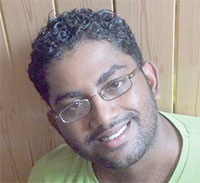THIS week at my school, we will celebrate science and scientists with our annual Science Fair which runs for an entire week and students are asked to present experiments, exhibitions, and innovative designs in technology as part of the celebration of STEAM (Science, Technology, Engineering, Art, Mathematics).
Science Fairs have, thankfully, increased in popularity in Guyana over the past few years, and the inclusion of Art is a welcome addition to a system of study that is designed to lead the children of the world into the technology-heavy future that they are expected to lead.
In thinking about the relationship between Art and the Sciences, I was obviously forced to contemplate the relationship between Literature and the Sciences. While unexplored in Guyana, there are many instances where the two overlap, and a quick survey of the few, but highly influential and important writers who had a relationship with science or contributed to science in some way, is sure to help those who may be unaware to learn of the many ways in which Literature and Science has maintained a relationship over centuries, and have continued to shape and inspire many aspects of each other through the years.
Recently, there was an article in The Guardian called “Charles Dickens” Contribution to Medicine highlighted in the London Exhibition”, written by the website’s science consultant, Hannah Devlin. The article highlighted an exhibition called “Charles Dickens: Man of Science” which aimed to show how Dickens, the famed writer of Great Expectations, A Christmas Carol, David Copperfield and many other classics of British literature, actually made some meaningful contributions to science through his writing. Devlin notes that Dickens “forensic descriptions of illness [in his literary work]” managed to “anticipate or even inspire later advances of medicine.”
An example of Dickens’ description of illness, according to “The Guardian” article, can be seen in the description of the character of Fat Boy Joe who appears in The Pickwick Papers. The character is an overweight boy who is troubled with snoring and sleeping,0 even as he runs errands during the daytime – symptoms that are now used to identify an illness now known as “Pickwickian syndrome.” Another example identified is that of dyslexia which manifests itself in the character of Mr Krook from Bleak House
who was unable to identify letters when placed together to form words. It is worth noting, as the article points out, that during Dickens’ time, dyslexia was yet unidentified as an illness.
Apart from Dickens, there have been other writers who have contributed to science in monumental ways. Jules Verne, for example, who wrote 20,000 Leagues Under the Sea, a novel about an undersea voyage that is conducted via a ship called the Nautilus that is designed to travel underwater. Verne’s Nautilus, according to Mark Strauss’ article in “Smithsonian” actually inspired Simon Lake to work on submarines. Lake went on to make several innovations – including the periscope (an iconic part of submarine machinery) – that resulted in the first submarine to be able to travel in the open ocean. The “Smithsonian” article also highlights another Jules Verne book – Clipper of the Clouds – as one of the elements to inspire Igor Sikorsky, the inventor of the modern helicopter.
In a second “Smithsonian” article called “The Many Futuristic Predictions of H.G. Wells That Came True”, Brian Handwerk outlines several scientific features from the science fiction works of H.G. Wells that are now in existence, or close to existence. H. G. Wells is well known as the author of The Time Machine, The War of the Worlds, and The Island of Dr Moreau. Handwerk’s article highlights elements of modern science and technology, such as genetic engineering, a form of which was presented in the animal/human hybrids that are created by the titular character in The Island of Dr Moreau. Also significant is Wells’ inclusion of early ideas about what would become modern day lasers and other energy directed weapons. Such items appeared in the novel, War of the Worlds, which has been adapted many times, with the incarnation most familiar to local audiences being Steven Spielberg’s 2005 film starring Tom Cruise and Dakota Fanning.
It is obvious that Literature and Science connect in many ways. However, the relationship between the two needs more observation and critical analysis, especially among audiences who may find it difficult to identify ways of establishing the important connection between the two. As seen in the few examples listed in this article, there is much to be gained from the connection between Literature and Science. The question, regarding the connection between these concepts, is what current works of science fiction in books may be able to offer to the realm of science in the future. What will we learn from Margaret Atwood’s dystopian Oryx and Crake? What insights into science and biology may Alex Garland’s Annihilation offer to us? Will the technology-driven world of Ernest Cline’s Ready Player One ever become a reality?



.jpg)








